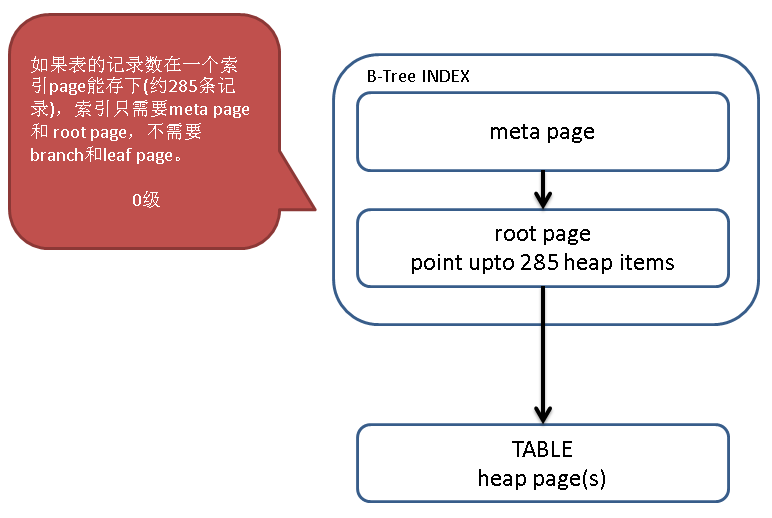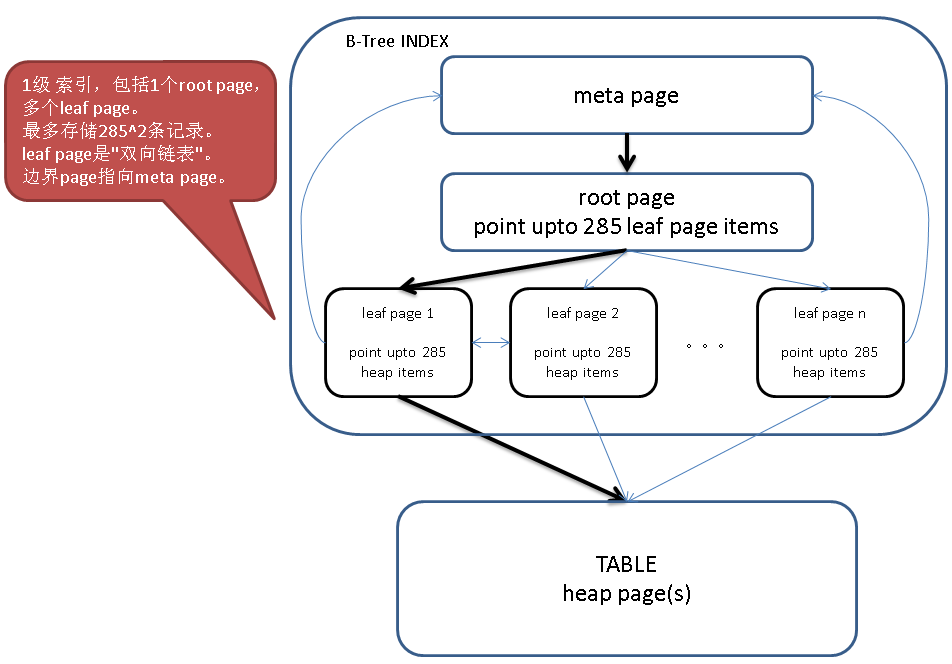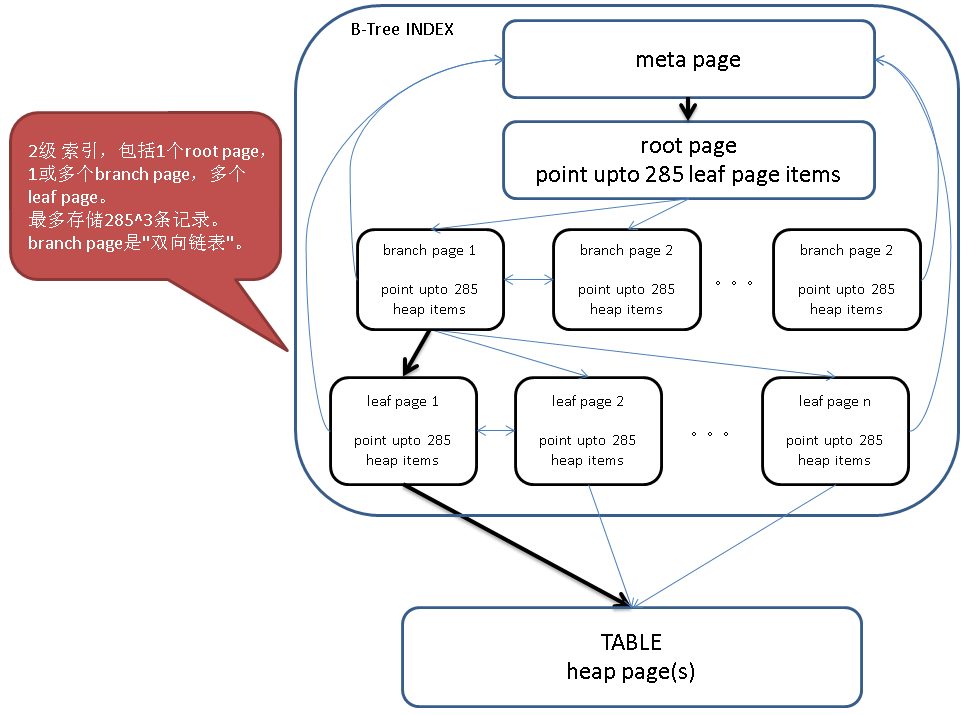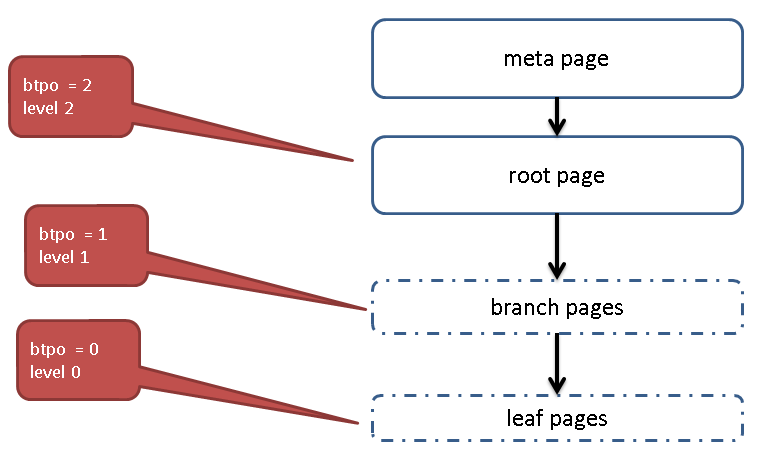本文共 22941 字,大约阅读时间需要 76 分钟。
PostgreSQL B-Tree是一种变种(high-concurrency B-tree management algorithm),算法详情请参考
src/backend/access/nbtree/READMEPostgreSQL 的B-Tree索引页分为几种类别
meta pageroot page # btpo_flags=2branch page # btpo_flags=0leaf page # btpo_flags=1如果即是leaf又是root则 btpo_flags=3。
其中meta page和root page是必须有的,meta page需要一个页来存储,表示指向root page的page id。
随着记录数的增加,一个root page可能存不下所有的heap item,就会有leaf page,甚至branch page,甚至多层的branch page。 一共有几层branch 和 leaf,就用btree page元数据的 level 来表示。
我们可以使用pageinspect插件,内窥B-Tree的结构。
层次可以从bt_page_stats的btpo得到,代表当前index page所处的层级。
注意层级并不是唯一的,例如btpo=3的层级,可能有分几个档。 打个比喻,腾讯的技术岗位级别T3,对应T3这个级别又有几个小的档位。和这里的含义差不多,只是没有区分小档位的值,但是后面我们能看到它的存在。 btpo=0级表示最底层,处于这个层级的index pages存储的items(ctid)是指向heap page的。 类别和层级不挂钩,类别里面又可以有多个层级,但是只有层级=0的index page存储的ctid内容才是指向heap page的; 其他层级index page存储的ctid内容都是指向同层级其他index page(双向链表),或者指下级的index page。 .1. 0层结构,只有meta和root页。 root页最多可以存储的item数,取决于索引字段数据的长度、以及索引页的大小。 例子
例子 postgres=# create extension pageinspect;postgres=# create table tab1(id int primary key, info text);CREATE TABLEpostgres=# insert into tab1 select generate_series(1,100), md5(random()::text);INSERT 0 100postgres=# vacuum analyze tab1;VACUUM
查看meta page,可以看到root page id = 1 。
索引的level = 0, 说明没有branch和leaf page。postgres=# select * from bt_metap('tab1_pkey'); magic | version | root | level | fastroot | fastlevel --------+---------+------+-------+----------+----------- 340322 | 2 | 1 | 0 | 1 | 0(1 row) 根据root page id = 1查看root page的stats
btpo=0 说明已经到了最底层 btpo_flags=3,说明它既是leaf又是root页。postgres=# select * from bt_page_stats('tab1_pkey',1); blkno | type | live_items | dead_items | avg_item_size | page_size | free_size | btpo_prev | btpo_next | btpo | btpo_flags -------+------+------------+------------+---------------+-----------+-----------+-----------+-----------+------+------------ 1 | l | 100 | 0 | 16 | 8192 | 6148 | 0 | 0 | 0 | 3(1 row) btpo_prev和btpo_next分别表示该页的相邻页(branch page是双向链表)。
btpo_flags 可以在代码中查看(src/include/access/nbtree.h),一共有几个
/* Bits defined in btpo_flags */#define BTP_LEAF (1 << 0) /* leaf page, i.e. not internal page */#define BTP_ROOT (1 << 1) /* root page (has no parent) */#define BTP_DELETED (1 << 2) /* page has been deleted from tree */#define BTP_META (1 << 3) /* meta-page */#define BTP_HALF_DEAD (1 << 4) /* empty, but still in tree */#define BTP_SPLIT_END (1 << 5) /* rightmost page of split group */#define BTP_HAS_GARBAGE (1 << 6) /* page has LP_DEAD tuples */#define BTP_INCOMPLETE_SPLIT (1 << 7) /* right sibling's downlink is missing */
查看0级 page存储的ctid (即items)
0级ctid 表示存储的是 heap页的寻址。 (如果是多层结构,那么branch page中的ctid, 它表示的是同级btree页(链条项ctid)或者下级btree页的寻址) 。 当ctid指向heap时, data是对应的列值。(多级结构的data意义不一样,后面会讲)postgres=# select * from bt_page_items('tab1_pkey',1); itemoffset | ctid | itemlen | nulls | vars | data ------------+---------+---------+-------+------+------------------------- 1 | (0,1) | 16 | f | f | 01 00 00 00 00 00 00 00 2 | (0,2) | 16 | f | f | 02 00 00 00 00 00 00 00... 99 | (0,99) | 16 | f | f | 63 00 00 00 00 00 00 00 100 | (0,100) | 16 | f | f | 64 00 00 00 00 00 00 00(100 rows) 根据ctid 查看heap记录
postgres=# select * from tab1 where ctid='(0,100)'; id | info -----+---------------------------------- 100 | 68b63c269ee8cc2d99fe204f04d0ffcb(1 row)
.2.
1层结构,包括meta page, root page, leaf page. 例子
例子 postgres=# truncate tab1;TRUNCATE TABLEpostgres=# insert into tab1 select generate_series(1,1000), md5(random()::text);INSERT 0 1000postgres=# vacuum analyze tab1;VACUUM
查看meta page,可以看到root page id = 3, 索引的level = 1。
level = 1 表示包含了leaf page。postgres=# select * from bt_metap('tab1_pkey'); magic | version | root | level | fastroot | fastlevel --------+---------+------+-------+----------+----------- 340322 | 2 | 3 | 1 | 3 | 1(1 row) 根据root page id 查看root page的stats
btpo = 1 说明还没有到最底层(最底层btpo=0, 这种页里面存储的ctid才代表指向heap page的地址) btpo_flags=2 说明这个页是root pagepostgres=# select * from bt_page_stats('tab1_pkey',3); blkno | type | live_items | dead_items | avg_item_size | page_size | free_size | btpo_prev | btpo_next | btpo | btpo_flags -------+------+------------+------------+---------------+-----------+-----------+-----------+-----------+------+------------ 3 | r | 3 | 0 | 13 | 8192 | 8096 | 0 | 0 | 1 | 2(1 row) 查看root page存储的 leaf page items (指向leaf page)
一共3个leaf pages, data存储的是这个leaf page存储的最小值。postgres=# select * from bt_page_items('tab1_pkey',3); itemoffset | ctid | itemlen | nulls | vars | data ------------+-------+---------+-------+------+------------------------- 1 | (1,1) | 8 | f | f | 2 | (2,1) | 16 | f | f | 6f 01 00 00 00 00 00 00 3 | (4,1) | 16 | f | f | dd 02 00 00 00 00 00 00(3 rows) 第一条为空,是因为这个leaf page是最左边的PAGE,不存最小值。
对于有右leaf page的leaf page,第一条存储的heap item为该页的右链路。 第二条才是起始ITEM。 另外需要注意,虽然在item里面只存储右链,leaf page还是双向链表,在stats能看到它的prev 和next page。 根据leaf page id查看stats 最左leaf page = 1 prev btpo 指向meta page可以看到btpo = 0了,说明这个页是底层页。 btpo_flags=1 说明是leaf page postgres=# select * from bt_page_stats('tab1_pkey',1); blkno | type | live_items | dead_items | avg_item_size | page_size | free_size | btpo_prev | btpo_next | btpo | btpo_flags -------+------+------------+------------+---------------+-----------+-----------+-----------+-----------+------+------------ 1 | l | 367 | 0 | 16 | 8192 | 808 | 0 | 2 | 0 | 1(1 row) next btpo 指向meta page
最右leaf page = 4 btpo_flags=1 说明是leaf pagepostgres=# select * from bt_page_stats('tab1_pkey',4); blkno | type | live_items | dead_items | avg_item_size | page_size | free_size | btpo_prev | btpo_next | btpo | btpo_flags -------+------+------------+------------+---------------+-----------+-----------+-----------+-----------+------+------------ 4 | l | 268 | 0 | 16 | 8192 | 2788 | 2 | 0 | 0 | 1(1 row) 中间leaf page = 2
btpo_flags=1 说明是leaf pagepostgres=# select * from bt_page_stats('tab1_pkey',2); blkno | type | live_items | dead_items | avg_item_size | page_size | free_size | btpo_prev | btpo_next | btpo | btpo_flags -------+------+------------+------------+---------------+-----------+-----------+-----------+-----------+------+------------ 2 | l | 367 | 0 | 16 | 8192 | 808 | 1 | 4 | 0 | 1(1 row) 查看leaf page存储的 heap ctid (即heap items)
含右页的例子, index page 1 第一条为右链表的第一条item, 第二条才是起始itempostgres=# select * from bt_page_items('tab1_pkey',1); itemoffset | ctid | itemlen | nulls | vars | data ------------+---------+---------+-------+------+------------------------- 1 | (3,7) | 16 | f | f | 6f 01 00 00 00 00 00 00 2 | (0,1) | 16 | f | f | 01 00 00 00 00 00 00 00 3 | (0,2) | 16 | f | f | 02 00 00 00 00 00 00 00... 367 | (3,6) | 16 | f | f | 6e 01 00 00 00 00 00 00(367 rows) 不含右页的例子, index page 4
第一条就是起始ctid (即items)postgres=# select * from bt_page_items('tab1_pkey',4); itemoffset | ctid | itemlen | nulls | vars | data ------------+---------+---------+-------+------+------------------------- 1 | (6,13) | 16 | f | f | dd 02 00 00 00 00 00 00 2 | (6,14) | 16 | f | f | de 02 00 00 00 00 00 00... 268 | (8,40) | 16 | f | f | e8 03 00 00 00 00 00 00(268 rows) 根据ctid 查看heap记录
postgres=# select * from tab1 where ctid='(0,1)'; id | info ----+---------------------------------- 1 | 6ebc6b77aebf5dd11621a2ed846c08c4(1 row)
.3.
记录数超过1层结构的索引可以存储的记录数时,会分裂为2层结构,除了meta page和root page,还可能包含1层branch page以及1层leaf page。 如果是边界页(branch or leaf),那么其中一个方向没有PAGE,这个方向的链表信息都统一指向meta page。 例子
例子 create table tbl1(id int primary key, info text); postgres=# select 285^2; ?column? ---------- 81225(1 row)postgres=# insert into tab2 select trunc(random()*10000000), md5(random()::text) from generate_series(1,1000000) on conflict on constraint tab2_pkey do nothing;INSERT 0 951379postgres=# vacuum analyze tab2;VACUUM
查看meta page,可以看到root page id = 412, 索引的level=2,即包括1级 branch 和 1级 leaf。
postgres=# select * from bt_metap('tab2_pkey'); magic | version | root | level | fastroot | fastlevel --------+---------+------+-------+----------+----------- 340322 | 2 | 412 | 2 | 412 | 2(1 row) 根据root page id 查看root page的stats
btpo = 2 当前在第二层,另外还表示下层是1 btpo_flags = 2 说明是root pagepostgres=# select * from bt_page_stats('tab2_pkey', 412); blkno | type | live_items | dead_items | avg_item_size | page_size | free_size | btpo_prev | btpo_next | btpo | btpo_flags -------+------+------------+------------+---------------+-----------+-----------+-----------+-----------+------+------------ 412 | r | 11 | 0 | 15 | 8192 | 7936 | 0 | 0 | 2 | 2(1 row) 查看root page存储的 branch page items (指向branch page)
postgres=# select * from bt_page_items('tab2_pkey', 412); itemoffset | ctid | itemlen | nulls | vars | data ------------+----------+---------+-------+------+------------------------- 1 | (3,1) | 8 | f | f | 2 | (2577,1) | 16 | f | f | e1 78 0b 00 00 00 00 00 3 | (1210,1) | 16 | f | f | ec 3a 18 00 00 00 00 00 4 | (2316,1) | 16 | f | f | de 09 25 00 00 00 00 00 5 | (574,1) | 16 | f | f | aa e8 33 00 00 00 00 00 6 | (2278,1) | 16 | f | f | 85 90 40 00 00 00 00 00 7 | (1093,1) | 16 | f | f | f6 e9 4e 00 00 00 00 00 8 | (2112,1) | 16 | f | f | a3 60 5c 00 00 00 00 00 9 | (411,1) | 16 | f | f | b2 ea 6b 00 00 00 00 00 10 | (2073,1) | 16 | f | f | db de 79 00 00 00 00 00 11 | (1392,1) | 16 | f | f | df b0 8a 00 00 00 00 00(11 rows) 根据branch page id查看stats
btpo = 1 当前在第一层 ,另外还表示下层是0 btpo_flags = 0 说明是branch pagepostgres=# select * from bt_page_stats('tab2_pkey', 3); blkno | type | live_items | dead_items | avg_item_size | page_size | free_size | btpo_prev | btpo_next | btpo | btpo_flags -------+------+------------+------------+---------------+-----------+-----------+-----------+-----------+------+------------ 3 | i | 254 | 0 | 15 | 8192 | 3076 | 0 | 2577 | 1 | 0(1 row) 查看branch page存储的 leaf page ctid (指向leaf page)
只要不是最右边的页,第一条都代表右页的起始item。 第二条才是当前页的起始ctid 注意所有branch page的起始item对应的data都是空的。 也就是说它不存储当前branch page包含的所有leaf pages的索引字段内容的最小值。postgres=# select * from bt_page_items('tab2_pkey', 3); itemoffset | ctid | itemlen | nulls | vars | data ------------+----------+---------+-------+------+------------------------- 1 | (735,1) | 16 | f | f | e1 78 0b 00 00 00 00 00 2 | (1,1) | 8 | f | f | 3 | (2581,1) | 16 | f | f | a8 09 00 00 00 00 00 00 4 | (1202,1) | 16 | f | f | f8 13 00 00 00 00 00 00... 254 | (3322,1) | 16 | f | f | ee 6f 0b 00 00 00 00 00(254 rows) 根据ctid 查看leaf page
btpo = 0 当前在第0层,即最底层,这里存储的是heap ctid btpo_flags = 1 说明是leaf pagepostgres=# select * from bt_page_stats('tab2_pkey', 1); blkno | type | live_items | dead_items | avg_item_size | page_size | free_size | btpo_prev | btpo_next | btpo | btpo_flags -------+------+------------+------------+---------------+-----------+-----------+-----------+-----------+------+------------ 1 | l | 242 | 0 | 16 | 8192 | 3308 | 0 | 2581 | 0 | 1(1 row)postgres=# select * from bt_page_items('tab2_pkey', 1); itemoffset | ctid | itemlen | nulls | vars | data ------------+------------+---------+-------+------+------------------------- 1 | (4985,16) | 16 | f | f | a8 09 00 00 00 00 00 00 2 | (7305,79) | 16 | f | f | 01 00 00 00 00 00 00 00 3 | (2757,120) | 16 | f | f | 09 00 00 00 00 00 00 00... 242 | (1329,101) | 16 | f | f | a0 09 00 00 00 00 00 00(242 rows) 查看leaf page中包含的heap page items。
如果我们根据索引页结构的原理,能推算出来(7305,79)是最小值,取它就没错了。postgres=# select * from tab2 where ctid='(7305,79)'; id | info ----+---------------------------------- 1 | 18aaeb74c359355311ac825ae2aeb22a(1 row)postgres=# select min(id) from tab2; min ----- 1(1 row).4. 多层结构,除了meta page,还可能包含多层branch page,以及一层leaf page。

postgres=# create table tab3(id int primary key, info text);CREATE TABLEpostgres=# insert into tab3 select generate_series(1, 100000000), md5(random()::text);
查看meta page, 注意level,已经是3级了。
meta pagepostgres=# select * from bt_metap('tab3_pkey'); magic | version | root | level | fastroot | fastlevel --------+---------+--------+-------+----------+----------- 340322 | 2 | 116816 | 3 | 116816 | 3(1 row) btpo_flags=2 代表 root page
btpo = 3 代表第3层postgres=# select * from bt_page_stats('tab3_pkey', 116816); blkno | type | live_items | dead_items | avg_item_size | page_size | free_size | btpo_prev | btpo_next | btpo | btpo_flags --------+------+------------+------------+---------------+-----------+-----------+-----------+-----------+------+------------ 116816 | r | 3 | 0 | 13 | 8192 | 8096 | 0 | 0 | 3 | 2(1 row)postgres=# select * from bt_page_items('tab3_pkey', 116816); itemoffset | ctid | itemlen | nulls | vars | data ------------+------------+---------+-------+------+------------------------- 1 | (412,1) | 8 | f | f | 2 | (116815,1) | 16 | f | f | 5f 9e c5 01 00 00 00 00 3 | (198327,1) | 16 | f | f | bd 3c 8b 03 00 00 00 00(3 rows) btpo_flags=0 代表 branch page
btpo = 2 代表第2层postgres=# select * from bt_page_stats('tab3_pkey', 412); blkno | type | live_items | dead_items | avg_item_size | page_size | free_size | btpo_prev | btpo_next | btpo | btpo_flags -------+------+------------+------------+---------------+-----------+-----------+-----------+-----------+------+------------ 412 | i | 286 | 0 | 15 | 8192 | 2436 | 0 | 116815 | 2 | 0(1 row)postgres=# select * from bt_page_items('tab3_pkey', 412); itemoffset | ctid | itemlen | nulls | vars | data ------------+-----------+---------+-------+------+------------------------- 1 | (81636,1) | 16 | f | f | 5f 9e c5 01 00 00 00 00 -- 这是指向当前层级右页的ctid 2 | (3,1) | 8 | f | f | -- 注意第一条初始值是这 3 | (411,1) | 16 | f | f | 77 97 01 00 00 00 00 00 4 | (698,1) | 16 | f | f | ed 2e 03 00 00 00 00 00... 286 | (81350,1) | 16 | f | f | e9 06 c4 01 00 00 00 00(286 rows) btpo_flags=0 代表 branch page
btpo = 1 代表第1层postgres=# select * from bt_page_stats('tab3_pkey', 3); blkno | type | live_items | dead_items | avg_item_size | page_size | free_size | btpo_prev | btpo_next | btpo | btpo_flags -------+------+------------+------------+---------------+-----------+-----------+-----------+-----------+------+------------ 3 | i | 286 | 0 | 15 | 8192 | 2436 | 0 | 411 | 1 | 0(1 row)postgres=# select * from bt_page_items('tab3_pkey', 3); itemoffset | ctid | itemlen | nulls | vars | data ------------+---------+---------+-------+------+------------------------- 1 | (287,1) | 16 | f | f | 77 97 01 00 00 00 00 00 2 | (1,1) | 8 | f | f | 3 | (2,1) | 16 | f | f | 6f 01 00 00 00 00 00 00 4 | (4,1) | 16 | f | f | dd 02 00 00 00 00 00 00... 286 | (286,1) | 16 | f | f | 09 96 01 00 00 00 00 00(286 rows) btpo_flags=1 代表 leaf page
btpo = 0 代表第0层postgres=# select * from bt_page_stats('tab3_pkey', 1); blkno | type | live_items | dead_items | avg_item_size | page_size | free_size | btpo_prev | btpo_next | btpo | btpo_flags -------+------+------------+------------+---------------+-----------+-----------+-----------+-----------+------+------------ 1 | l | 367 | 0 | 16 | 8192 | 808 | 0 | 2 | 0 | 1(1 row)postgres=# select * from bt_page_items('tab3_pkey', 1); itemoffset | ctid | itemlen | nulls | vars | data ------------+---------+---------+-------+------+------------------------- 1 | (3,7) | 16 | f | f | 6f 01 00 00 00 00 00 00 2 | (0,1) | 16 | f | f | 01 00 00 00 00 00 00 00 3 | (0,2) | 16 | f | f | 02 00 00 00 00 00 00 00... 367 | (3,6) | 16 | f | f | 6e 01 00 00 00 00 00 00(367 rows) 通过第0层的ctid就可以获取到heap了.
heap tuple例子postgres=# select * from tab3 where ctid='(0,1)'; id | info ----+---------------------------------- 1 | 370ee1989a2b7f5d8a5b43243596d91f(1 row)
如何解释explain analyze中的扫描了多少个btree page
实战例子1postgres=# create table tbl1(id int primary key, info text);CREATE TABLEpostgres=# insert into tbl1 select trunc(random()*10000000), md5(random()::text) from generate_series(1,5000000) on conflict on constraint tbl1_pkey do nothing;INSERT 0 3934875postgres=# select ctid,* from tbl1 limit 10; ctid | id | info --------+---------+---------------------------------- (0,1) | 2458061 | 5c91812b54bdcae602321dceaf22e276 (0,2) | 8577271 | fe8e7a8be0d71a94e13b1b5a7786010b (0,3) | 4612744 | 56983e47f044b5a4655300e1868d2850 (0,4) | 3690167 | 4a5ec8abf67bc018dcc113be829a59da (0,5) | 2646638 | 7686b47dcb94e56c11d69ec04d6017f3 (0,6) | 6023272 | 4779d9a849c8287490be9d37a27b4637 (0,7) | 7163674 | 35af37f479f48caa65033a5ef56cd75e (0,8) | 4049257 | 12fa110d927c88dce0773b546cc600c6 (0,9) | 5815903 | 69ed9770ede59917d15ac2373ca8c797 (0,10) | 4068194 | 738595f73670da7ede40aefa8cb3d00c(10 rows)postgres=# vacuum analyze tbl1;VACUUM
首先我们需要了解索引的level,才能正确的判断需要扫描多少个index page才能取出1条记录。
postgres=# select * from bt_metap('tbl1_pkey'); magic | version | root | level | fastroot | fastlevel --------+---------+------+-------+----------+----------- 340322 | 2 | 412 | 2 | 412 | 2(1 row) level = 2的btree应该长这样

.1. 以下查询,命中了1条记录,并且走的是index only scan。
读了4个INDEX PAGE, 包括1 meta page, 1 root page, 1 branch page, 1 leaf page.postgres=# explain (analyze,verbose,timing,costs,buffers) select id from tbl1 where id = 1; QUERY PLAN ---------------------------------------------------------------------------------------------------------------------------- Index Only Scan using tbl1_pkey on public.tbl1 (cost=0.42..1.44 rows=1 width=4) (actual time=0.019..0.020 rows=1 loops=1) Output: id Index Cond: (tbl1.id = 1) Heap Fetches: 0 Buffers: shared hit=4 Planning time: 0.072 ms Execution time: 0.072 ms(7 rows)
.2. 以下查询,命中了0条记录,并且走的是index only scan。
读了4个INDEX PAGE, 包括1 meta page, 1 root page, 1 branch page, 1 leaf page. 但是explain只算了3个,没有计算leaf page的那次,算个小BUG吧。postgres=# explain (analyze,verbose,timing,costs,buffers) select id from tbl1 where id in (3); QUERY PLAN ---------------------------------------------------------------------------------------------------------------------------- Index Only Scan using tbl1_pkey on public.tbl1 (cost=0.43..1.45 rows=1 width=4) (actual time=0.010..0.010 rows=0 loops=1) Output: id Index Cond: (tbl1.id = 3) Heap Fetches: 0 Buffers: shared hit=3 Planning time: 0.073 ms Execution time: 0.031 ms(7 rows)
.3. 以下查询,命中了7条记录,并且走的是index only scan。
读了22个INDEX PAGE, 1 meta page + 7 * (1 root + 1 branch + 1 leaf) = 22 也就是说,每个value都扫了root,branch,leaf。postgres=# explain (analyze,verbose,timing,costs,buffers) select id from tbl1 where id in (1,2,3,4,100,1000,10000); QUERY PLAN ----------------------------------------------------------------------------------------------------------------------------- Index Only Scan using tbl1_pkey on public.tbl1 (cost=0.42..10.10 rows=7 width=4) (actual time=0.018..0.033 rows=7 loops=1) Output: id Index Cond: (tbl1.id = ANY ('{1,2,3,4,100,1000,10000}'::integer[])) Heap Fetches: 0 Buffers: shared hit=22 Planning time: 0.083 ms Execution time: 0.056 ms(7 rows) .4. 以下查询,命中了2条记录,并且走的是index only scan。
读了22个INDEX PAGE, 1 meta page + 7 * (1 root + 1 branch + 1 leaf) = 22 也就是说,每个value都扫了root,branch,leaf。postgres=# explain (analyze,verbose,timing,costs,buffers) select id from tbl1 where id in (1,2,3,4,5,6,7); QUERY PLAN ----------------------------------------------------------------------------------------------------------------------------- Index Only Scan using tbl1_pkey on public.tbl1 (cost=0.43..10.13 rows=7 width=4) (actual time=0.039..0.046 rows=2 loops=1) Output: id Index Cond: (tbl1.id = ANY ('{1,2,3,4,5,6,7}'::integer[])) Heap Fetches: 0 Buffers: shared hit=22 Planning time: 0.232 ms Execution time: 0.086 ms(7 rows) .5. 以下查询结果和以上查询一样,也命中了3条记录,并且走的是index only scan。
但是只读了4个INDEX PAGE, 1 meta page + 1 root + 1 branch + 1 leafpostgres=# explain (analyze,verbose,timing,costs,buffers) select id from tbl1 where id>0 and id <=7; QUERY PLAN ---------------------------------------------------------------------------------------------------------------------------- Index Only Scan using tbl1_pkey on public.tbl1 (cost=0.43..1.49 rows=3 width=4) (actual time=0.008..0.009 rows=2 loops=1) Output: id Index Cond: ((tbl1.id > 0) AND (tbl1.id <= 7)) Heap Fetches: 0 Buffers: shared hit=4 Planning time: 0.127 ms Execution time: 0.028 ms(7 rows)
对于第四个查询,扫描了22个块,这个查询,优化器有优化的空间,比如找到1和7作为边界值,在查询到第一个值时,就可以取到leaf page的下一个page的最小值,从而得到1,2,3,4,5,6,7的值在当前page就可以完全取到,不需要去重复扫描。
转载地址:http://gcvxl.baihongyu.com/